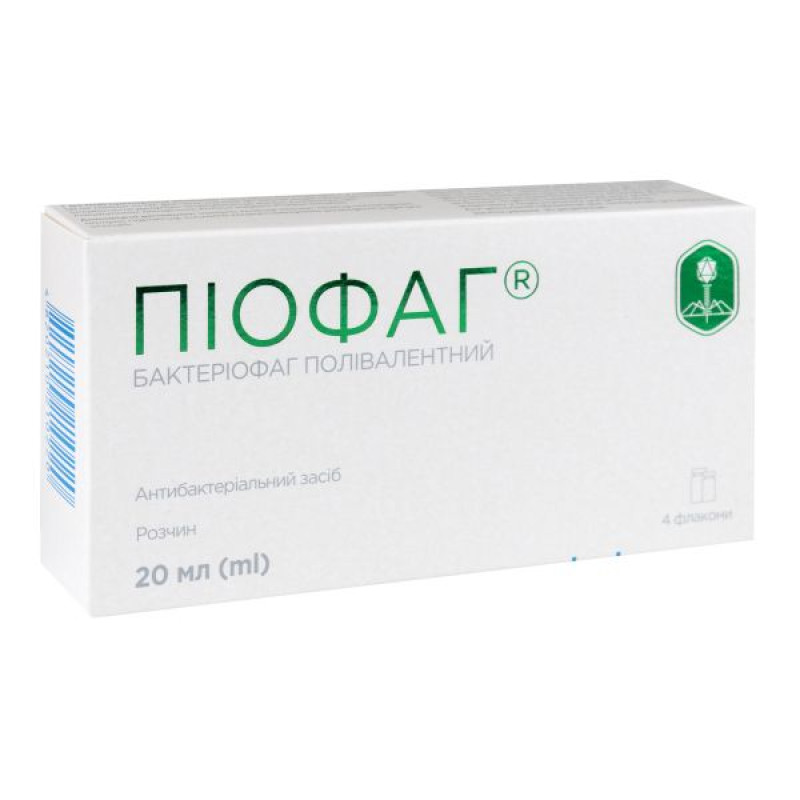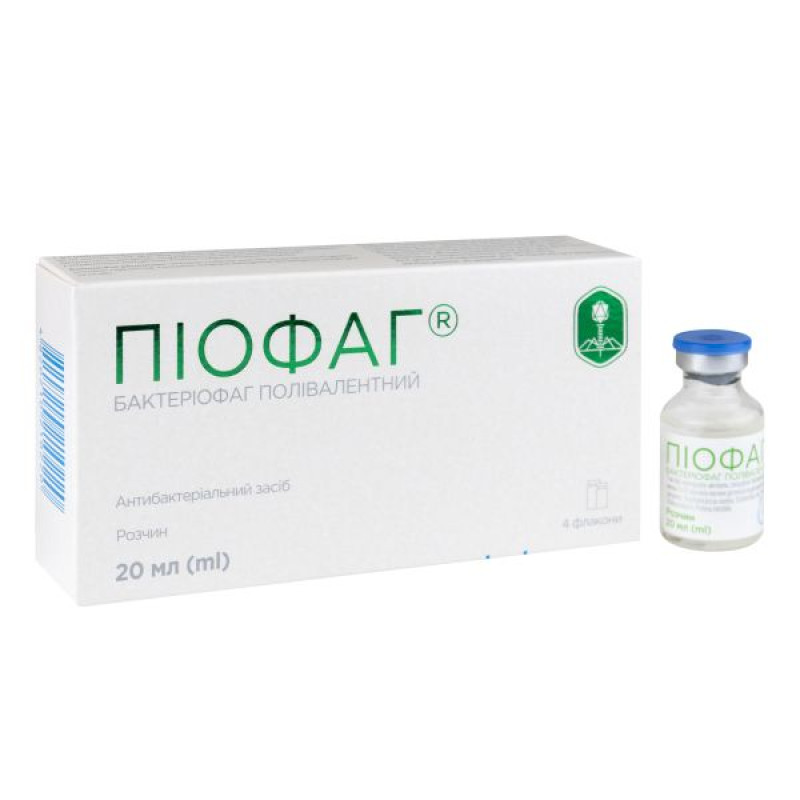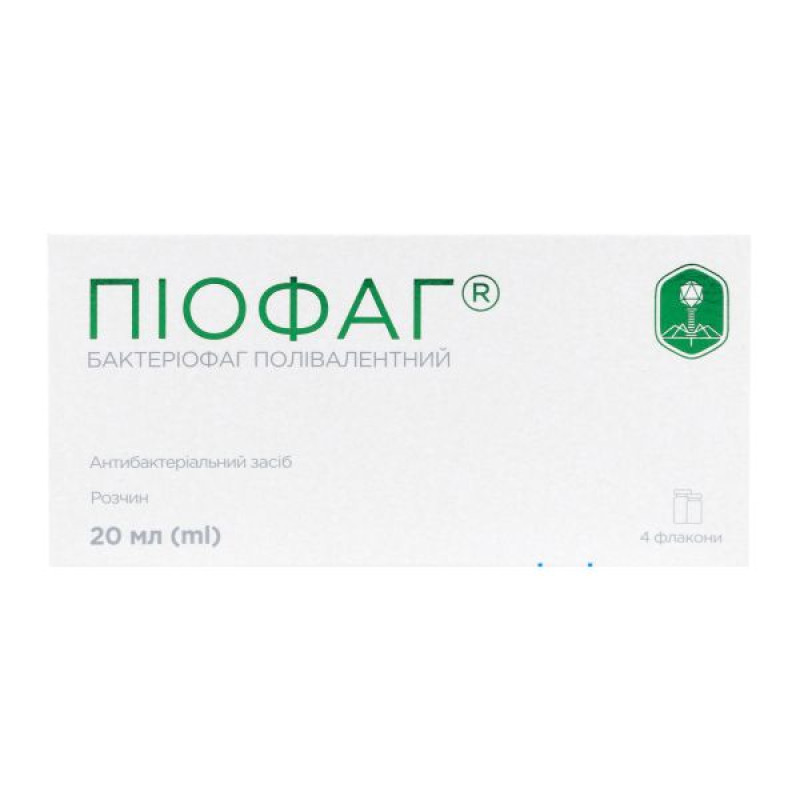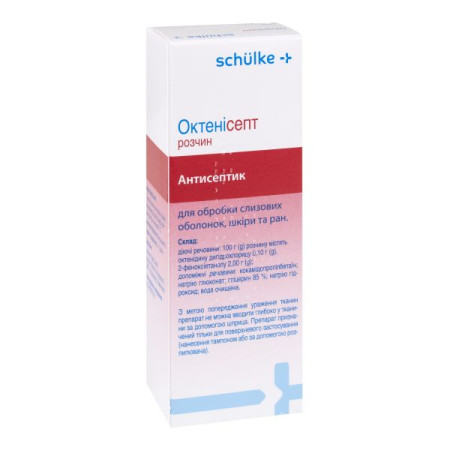Piofag bacteriophage polyvalent solution bottle 20 ml No. 4

Instructions for use: Piofag bacteriophage polyvalent solution, bottle 20 ml, No. 4
Composition
active ingredient: 1 ml of the drug contains specific bacteriophages at a concentration of at least 1×105 phage particles for the following types of microorganisms: Streptococcus pyogenes, Staphylococcus aureus, Escherichia coli, Pseudomonas aeruginosa, Proteus vulgaris, Proteus mirabilis;
Excipients: sodium chloride; magnesium chloride hexahydrate; sodium hydroxide; diluted hydrochloric acid; water for injections.
Dosage form
Solution.
Main physicochemical properties: clear liquid, a yellowish tint is allowed.
Pharmacotherapeutic group
Antibacterial agents. Other antibacterial agents. ATX code J01X X
Pharmacological properties
Immunobiological and biological properties.
The drug has the ability to specifically lyse bacteria such as Streptococcus pyogenes, Staphylococcus aureus, Escherichia coli, Pseudomonas aeruginosa, Proteus vulgaris, Proteus mirabilis. Bacteriophages specifically infect bacterial cells, multiply inside the bacterial cell and destroy it by lysis. The antibacterial effect of the drug is due to the specific lysis of pathogenic bacteria, while the drug does not disrupt the state of normal microflora. Under the action of the bacteriophage, phagocytosis is activated, the activity of neutrophils and their metabolic activity increases, which prevents the recurrence of an infectious disease and the chronicity of the inflammatory process. The number of leukocytes and neutrophils decreases, and the level of lymphocytes increases mainly due to T-lymphocytes. Bacteriophages penetrate the blood and lymph for a short time and are excreted by the kidneys with urine.
Indication
Treatment and prevention of purulent-inflammatory and intestinal diseases caused by staphylococci, streptococci, Pseudomonas aeruginosa, pathogenic Escherichia coli of various serogroups, Proteus. The drug is used as monotherapy or as part of combination therapy.
Contraindication
Hypersensitivity to the components of the drug.
Special safety precautions
An important condition for effective phage therapy is the preliminary determination of the phage sensitivity of the pathogen. The drug should be started as early as possible. The drug should not be used if the solution is cloudy.
Interaction with other medicinal products and other types of interactions
The drug can be used in combination with other antibacterial agents, as well as as monotherapy – if the patient is intolerant to antibiotic therapy, or if the strains of the pathogen are resistant to antibiotics.
Application features
This medicinal product contains less than 1 mmol (23 mg) sodium/dose, i.e. essentially 'sodium-free'.
Use during pregnancy or breastfeeding
Safety and efficacy have not been established, so use is contraindicated.
Ability to influence reaction speed when driving vehicles or other mechanisms
The use of the drug does not affect the reaction speed when driving vehicles or other mechanisms.
Method of administration and doses
Treatment of purulent-inflammatory diseases with localized lesions should be carried out simultaneously both locally and orally. The duration of treatment is 7–20 days.
When dosing the drug, follow the instructions for medical use. In the case of using low doses (2–8 drops), the drug must be drawn up with a sterile syringe with a volume of 0.5–1 ml or use a spray nozzle. 1 milliliter of the drug contains 20 drops of bacteriophage solution, 1 injection with a spray nozzle contains 0.2 ml of solution.
Locally used in the form of irrigation, lotions and tamponade with liquid phage in an amount of up to 200 ml depending on the size of the affected area. In abscesses, the bacteriophage is injected into the cavity of the focus after removing pus by puncture. The amount of the drug injected should be slightly less than the volume of removed pus. In osteomyelitis, after appropriate surgical treatment, bacteriophage is infused into the wound in an amount of 10–20 ml.
Introduction into cavities – pleural, articular and other limited cavities – up to 100 ml of bacteriophage, after which capillary drainage is left, through which the bacteriophage is re-injected within several days.
In case of cystitis, pyelonephritis, urethritis, the drug is taken orally. If the cavities of the bladder or renal pelvis are drained, the bacteriophage is administered through a cystostomy or nephrostomy 1–2 times a day, 20–50 ml into the bladder and 5–7 ml into the renal pelvis.
For purulent-inflammatory gynecological diseases, the drug is injected into the vaginal cavity and uterus in a dose of 5–10 ml once daily.
For purulent-inflammatory diseases of the ear (otitis), throat (sore throat), nose, the drug is administered in a dose of 2–10 ml 1–3 times a day. The bacteriophage is used for rinsing, washing, instillation, and wetting turundas (which are administered and left for 1 hour).
In the treatment of stomatitis and chronic generalized periodontitis, the drug is used as a mouth rinse 3–4 times a day in a dose of 10–20 ml, and turundas impregnated with the drug are also inserted into the periodontal pockets for 5–10 minutes.
In intestinal forms of the disease, diseases of internal organs, dysbacteriosis, the drug is used orally and in an enema. Orally, the bacteriophage is taken 3 times a day on an empty stomach, 1 hour before meals.
The recommended dosage of the drug is given in Table 1.
Table 1
| Age | Dose per 1 dose (ml) |
| within | |
| Up to 6 months | 5 |
| From 6 to 12 months | 10 |
| From 1 to 3 years | 15 |
| From 3 to 8 years old | 20 |
| From 8 years old | 30 |
The use of bacteriophages does not exclude the use of other antibacterial drugs. If chemical antiseptics were used to treat wounds before using bacteriophages, the wound should be thoroughly washed with sterile 0.9% sodium chloride solution.
In intestinal forms of the disease, rectal administration of the bacteriophage is possible once a day in the form of an enema after emptying the bowels instead of 1 oral dose.
The recommended dosage of the drug when administered rectally is listed in Table 2.
Table 2
| Age | Dose per 1 dose (ml) |
| rectally | |
| Up to 6 months | 10 |
| From 6 to 12 months | 20 |
| From 1 to 3 years | 30 |
| From 3 to 8 years old | 40 |
| From 8 years old | 50 |
For preventive purposes, the optimal regimen is daily oral administration of a single age-appropriate dose. The duration of administration is determined by the conditions of the epidemic situation.
Children.
The drug is intended for use in children.
Overdose
Cases of drug overdose have not been described.
Side effects
Cases of adverse reactions have not been described.
Expiration date
3 years.
Storage conditions
Store at a temperature of 2 to 8 °C in the original packaging. After the first opening of the bottle, storage is possible for no more than 10 days at a temperature of 2 to 8 °C. Transportation is allowed at a temperature not higher than 25 °C for no more than 30 days, then the drug is stored at a temperature of 2 to 8 °C.
Incompatibility
Do not mix with other medicines.
Packaging
Solution in 10 ml bottles No. 4 complete with dropper caps or without dropper caps in cardboard packs; in 20 ml bottles No. 1 complete with spray nozzle in cardboard packs; in 20 ml bottles No. 4 complete with spray nozzle or without spray nozzle in cardboard packs; in 50 ml bottles No. 1 in cardboard packs.
Vacation category
According to the recipe.
Producer
Private Joint Stock Company "Infuzia", Ukraine, for NEO PROBIO CARE INC., Canada.
Location of the manufacturer and its business address.
23219, Vinnytsia region, Vinnytsia district, village of Vinnytskie Khutory, Nemyrivske highway st., bldg. 84A.
٭ The instructions that will be included in the cardboard pack will list only one manufacturer (the one that was used to produce the series).
Applicant
NEO PROBIO CARE INC., Canada.
Location of the applicant.
599 Century Drive, Burlington, Ontario, L7T 4L7, Canada
There are no reviews for this product.
There are no reviews for this product, be the first to leave your review.
No questions about this product, be the first and ask your question.










